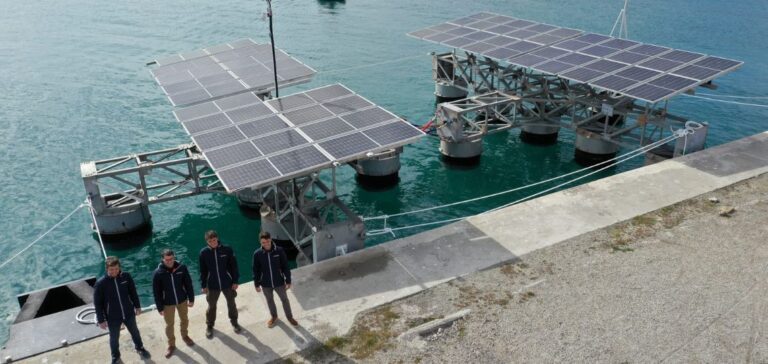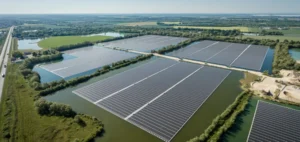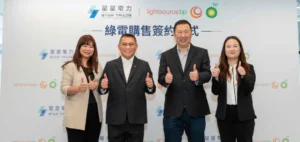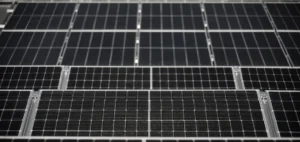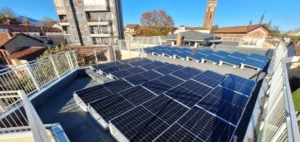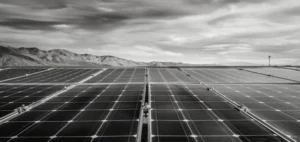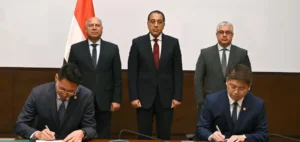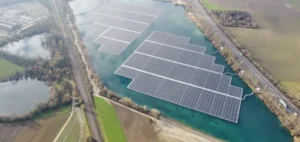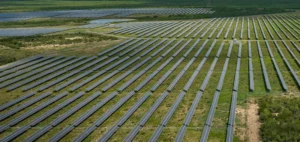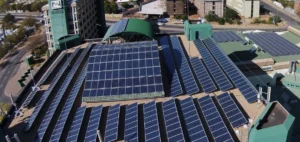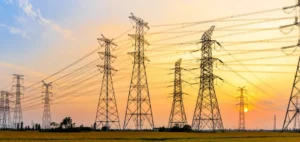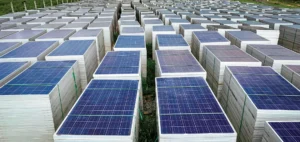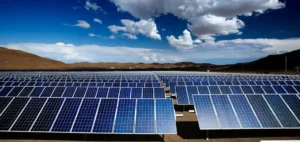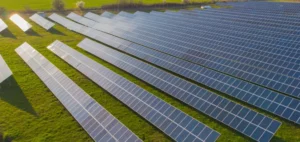SolarinBlue has launched its first floating offshore solar power plant in the Mediterranean. Specially designed for the maritime environment, it will supply the port of Sète-Frontignan (34) with renewable electricity. This new technology is ahead of offshore wind power and is part of the decarbonization strategy of the port of Sète. SolarinBlue aims to be the world leader in floating offshore solar PV.
First floating offshore solar power plant in the Mediterranean
The technology startup SolarinBlue has launched the first two units of its Sun’Sète project in the Mediterranean. They are specially designed for the maritime environment and will supply the port of Sète-Frontignan with renewable electricity.
The Sun’Sète project has been developed from 2021 and has obtained the approval of the port authorities and all the necessary administrative authorizations in 2022. It will be composed of 25 floating units for a total power of 300 kWp on 0.5 hectare. The energy produced will be transported by a submarine cable and will supply the infrastructures of the port of Sète-Frontignan with renewable electricity.
The floating offshore solar power plant, an economic and ecological project
The SolarinBlue float is distinguished by four major innovations that make it robust and competitive. It is lightweight, making it easy to build, assemble and operate at sea. It is also eco-designed and 95% recyclable thanks to a treated steel frame and recyclable High Density Polyethylene (HDPE) floats. The technology withstands 12-meter troughs and 200 km/h winds, making it robust and lightweight. It also has a lifespan of 30 years. Finally, SolarinBlue has developed a rapid installation system for environmentally friendly helical anchors that minimize the impact on the seabed.
The objective is to meet the massive needs for decarbonized electricity in populated areas
More than 3.8 billion people reside within 150 km of a coastline, making it an ideal location for offshore floating solar photovoltaic power generation. Indeed, it allows to meet the massive needs of decarbonized electricity in populated areas thanks to these untapped photovoltaic production deposits. The floating offshore solar power plant developed by SolarinBlue thus enables this vast decarbonization potential to be realized.
Offshore floating photovoltaic is considered as the answer to the land constraint of terrestrial photovoltaic. Indeed, it does not require large land areas, which avoids the competition of use that limits the expansion of solar energy. In addition, floating offshore photovoltaic is very competitive. It is free from land use conflicts while being economically profitable.
Decarbonizing port facilities
The deployment of floating photovoltaic farms at sea is also a response to the decarbonization of port, industrial or recreational facilities, as well as island systems. The European Union has foreseen an increasing electrification of port uses in the framework of the Green Pact for Europe and “Fit for 55”. This is an opportunity for offshore floating photovoltaic farms to develop and contribute to the reduction of carbon emissions.
Possible synergies with offshore wind power
Offshore floating photovoltaics can benefit from synergies with offshore wind farms, whether they are installed or floating. This is made possible through connection pooling. Indeed, photovoltaic and wind power benefit from a favorable abundance, because the sun produces more in summer, against wind power in winter.
The floating offshore solar power plant, a made-in-Occitania project
The SolarinBlue technology is designed in France and developed by about 20 people, including mechanical engineers, hydro-dynamicists, naval architects and roboticists. Tests in the basin preceded the launching of the demonstrator. The project was manufactured and assembled in the port of Sète by local companies. About thirty companies from Occitania have been mobilized for the environmental studies, the supply of materials, the assembly, the logistics and the tests of an innovative and ecological anchorage.

